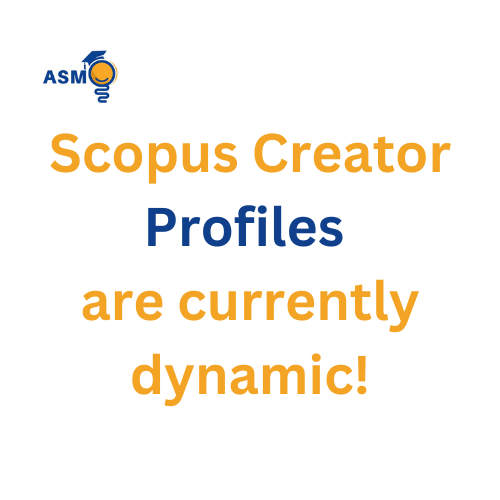Scopus Creator Author Profiles are dynamic and continuously updated to reflect the latest research outputs and collaborations. Here’s what you should know and how to manage your profile effectively:
Key Features of Scopus Creator Author Profiles
- Dynamic Updates:
- Automatically updated when your new publications are indexed in Scopus.
- Reflects changes in your affiliations and co-authorships.
- Unique Author ID:
- Each researcher is assigned a unique Scopus Author Identifier, which tracks your publications and citations accurately.
- Metrics and Analytics:
- Provides metrics such as h-index, total citations, and subject area breakdowns.
- Tracks collaborations, co-authors, and publication trends.
- Publication List:
- Lists all articles, reviews, and conference papers indexed in Scopus under your authorship.
- Profile Customization:
- Allows researchers to request corrections to name variations, affiliations, or publication mismatches.
How to Manage Your Scopus Profile
- Access Your Profile:
- Visit the Scopus Author Search: Scopus Author Search
- Search for your name or Scopus Author ID.
- Verify Your Publications:
- Ensure all your publications are correctly listed.
- If there are discrepancies:
- Use the Author Feedback Wizard to report errors.
- Merge Duplicate Profiles:
- If you have multiple profiles due to name variations or different affiliations, request a profile merge via the Author Feedback Wizard.
- Update Your Profile:
- Add alternative names or affiliation history.
- Link your profile to ORCID for better visibility and synchronization.
- Monitor Metrics:
- Regularly check your citation counts and h-index to track your academic impact.
Step 1: Access Your Scopus Author Profile
- Go to the Scopus Author Search.
- Enter your name, affiliation, or Scopus Author ID.
- Locate your profile in the search results.
Step 2: Verify Your Publications
- Click on your profile to view the list of publications.
- Cross-check that all listed publications are authored by you.
- If publications are missing or mismatched, use the Author Feedback Wizard to:
- Add missing articles.
- Remove incorrectly attributed articles.
- If publications are missing or mismatched, use the Author Feedback Wizard to:
Step 3: Merge Duplicate Profiles
- If you find multiple profiles under different names or affiliations:
- Click Request to merge authors in the Author Feedback Wizard.
- Provide information about all profiles that belong to you.
- Wait for Scopus to process the merge request, which can take a few weeks.
Step 4: Link Your Profile to ORCID
- Create or log in to your ORCID account.
- Link your Scopus profile to ORCID through the Author Feedback Wizard or directly in your Scopus profile.
- This ensures synchronization of publications and boosts visibility.
Step 5: Update Profile Information
Add alternative name variations to account for different spellings or initials used in publications.
- Update affiliation history to reflect your academic or professional journey accurately.
Step 6: Monitor and Track Metrics
- Regularly check:
- h-index: A measure of your research impact.
- Citations per article: Insights into the influence of individual publications.
- Collaboration networks: Identify potential new collaborators.
- Use Scopus tools for deeper analytics, such as trends in your research area.

Benefits of a Well-Maintained Profile
- Increases visibility among peers and potential collaborators.
- Enhances credibility with accurate citation data.
- Helps institutions and funding agencies assess your research output.
This implies that specialists can follow their exhibition, and quest for specialists and teammates, from anyplace, whenever, utilizing their cell phone or other cell phone.
Features of the new mobile-friendly design are:
Programmed acclimation to fit the screen of any cell phone or more modest screen
Streamlined designs, menus and controls for the little screen
Upgraded openness, so the profiles can be utilized really by anybody
To see your Scopus Creator profile on a cell phone, just go to the Scopus site and sign in. Your profile will consequently conform to fit the screen of your gadget.
Here are a portion of the advantages of having a versatile Scopus Creator profile:
You can follow your presentation and examination influence in a hurry.
You can undoubtedly find and interface with specialists and colleagues, no matter what their area.
By sharing your profile on social media and other online platforms, you can get the word out about your research to a wider audience.
In the event that you don’t have a Scopus Creator profile yet, making one is simple. Essentially go to the Scopus site and snap on the “Make a record” button. Whenever you have made a record, you can add your own data, schooling, work insight, and distributions to your profile.
Scopus Creator profiles are an important device for specialists, all things considered. By making them dynamic, Elsevier has made it considerably more straightforward for analysts to remain associated with their examination local area and advance their work.


